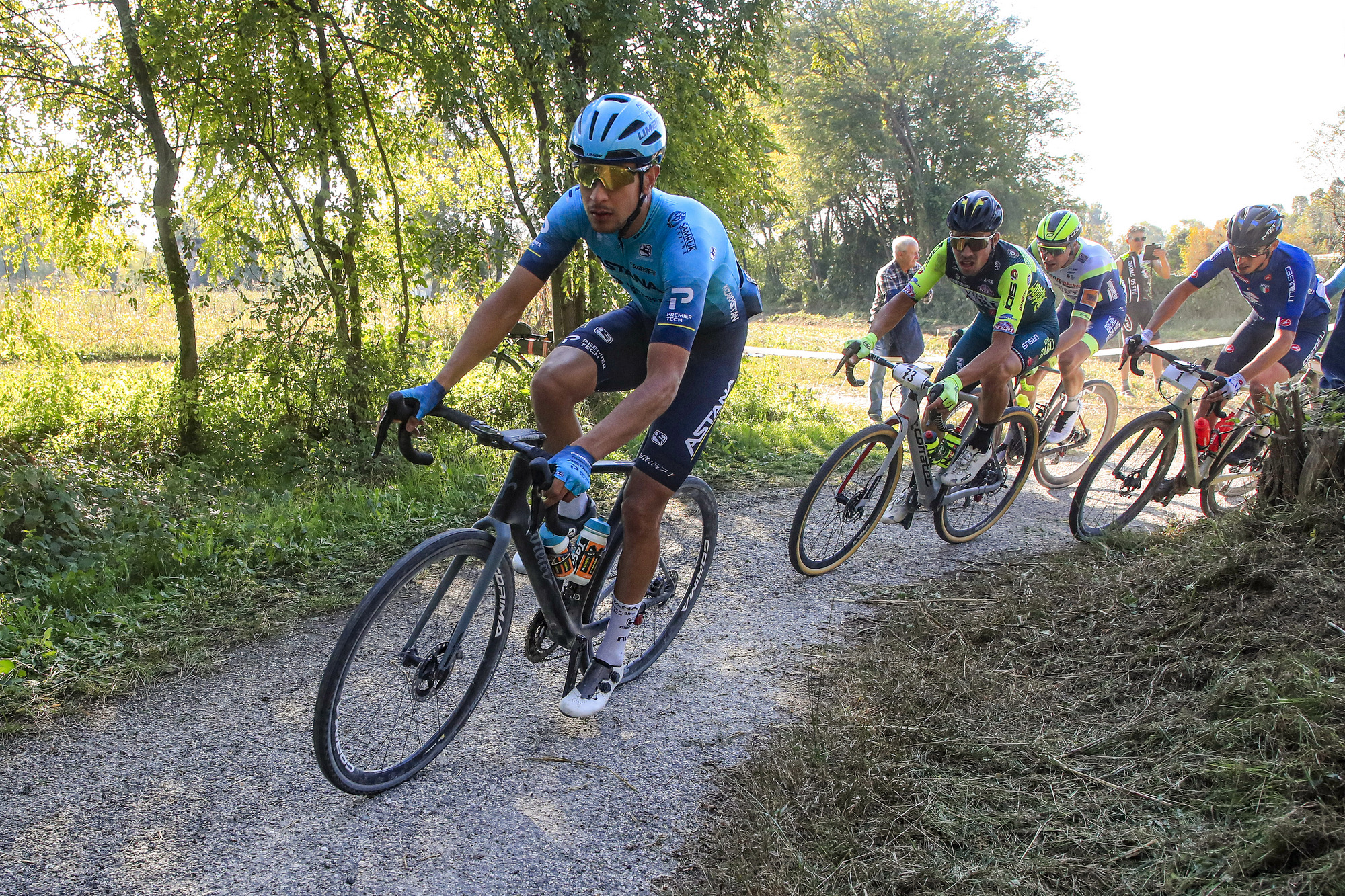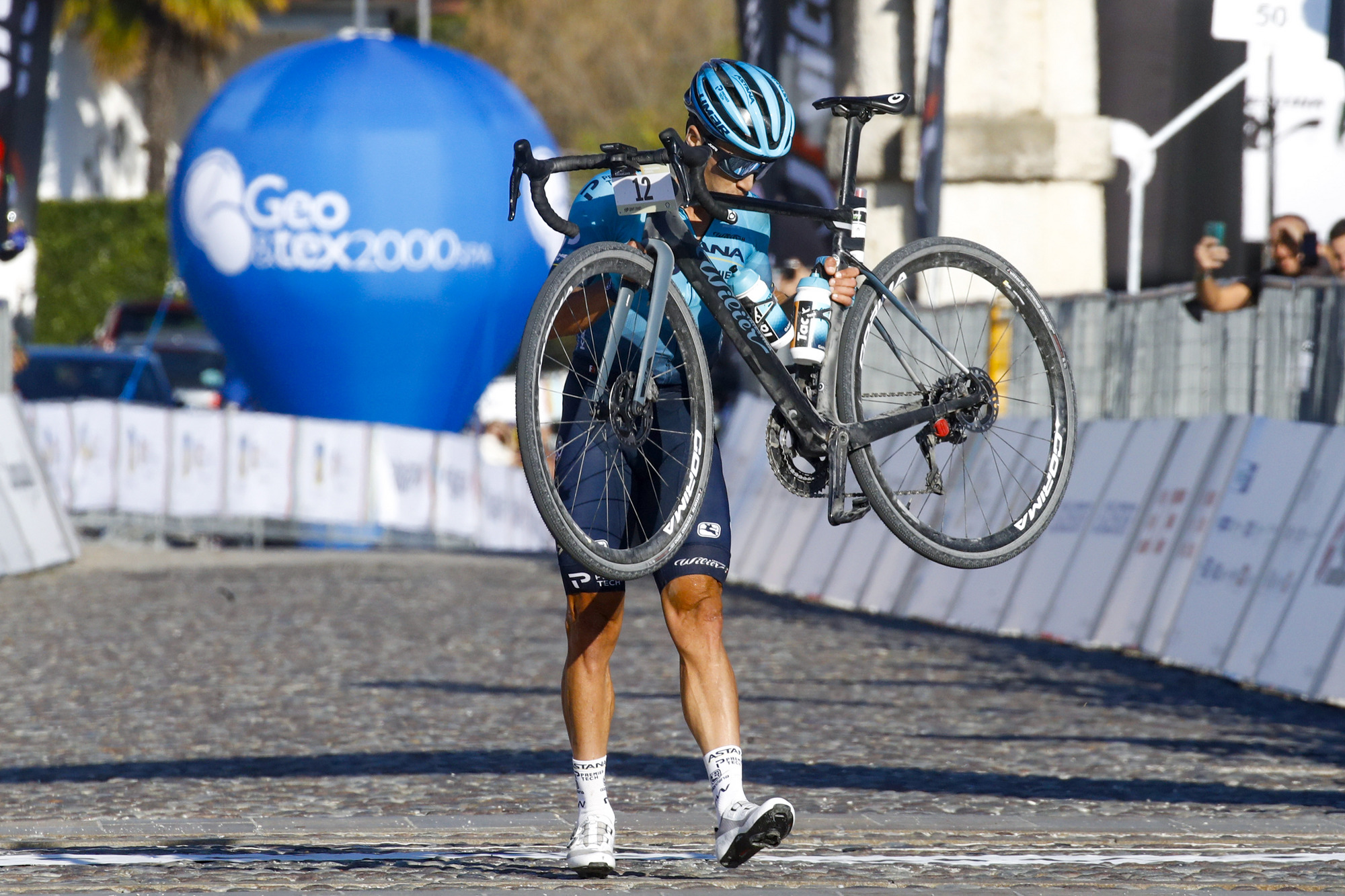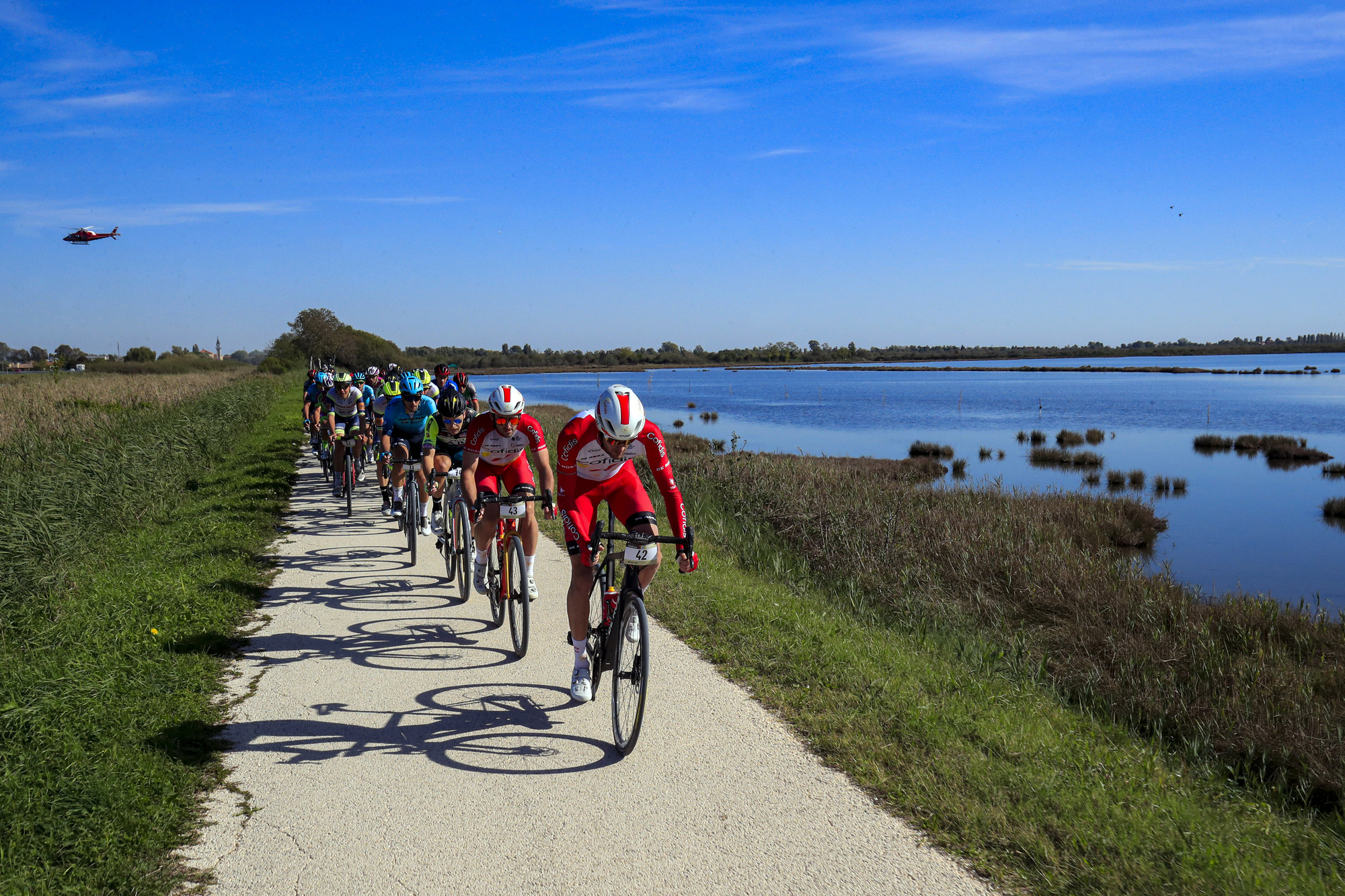Riding to win, not to just take part: Inside the pioneering Serenissima Gravel pro race
Riders talk team tactics, tyre pressure and racing solitude in the Veneto

The first sign that the Serenissima Gravel was no ordinary professional race was visible outside the Astana-Premier Tech bus in the team paddock in Lido di Jesolo. Four new Wilier Rave SLR bikes stood on ceremony with tubes of sealant taped around the seat post. All year around, riders simply raise their arms to beckon a wheel change in the event of a puncture. At Serenissima Gravel, with no following team cars and outside support allowed, they would have to carry out any repairs for themselves.
Serenissima Gravel was billed as the first gravel race for professional riders, and as such it offered a point of confluence between the seemingly distant worlds of elite, UCI regulated competition and gravel riding. Some familiar features of the emerging discipline were present – wide-section tyres and race numbers on the handlebars – but so too was the bottom of line of pro racing. Or, as Astana Premier Tech directeur sportif Giuseppe Martinelli put it: “In the end, we’re here to compete, not to participate.”
That sentiment might seem anathema to the inclusive, mass-participation spirit of gravel racing, but for WorldTour teams and ProTeams alike, a bike race is always a bike race, even one as novel and experimental as Serenissima Gravel. And for Astana, whose bike supplier Wilier Triestina hails from nearby Rossano Veneto, there was extra motivation to showcase the brand’s new gravel machine on what amounted to home sterrato.
Scarcity of equipment, due to the late-season date and the distribution issues triggered by the coronavirus pandemic last year, had contributed to the absence of some teams and limited the field to just 34 riders spread across eleven squads. Among those who made the start line, meanwhile, there were some divergences in material.
At Cofidis Fernando Barcelo, Attilio Viviani and Thomas Champion lined out on what amounted to something resembling a Strade Bianche bike, albeit equipped with thicker tyres. Gravel enthusiast Nathan Haas, however, was already the owner of a De Rosa gravel bike, and he rode that machine on Friday, kitted out with Campagnolo’s gravel-specific Ekar groupset.
“Normally I use a 38-tooth chainring because I do gravel with climbing, but today I’m using a 44-tooth because today is flat as a pancake. 44 seems small when you compare it to the 53 on the road, but my smallest cog on the back is actually a 9, so it ends up being a 44x9, which is a pretty huge gear,” Haas told Cyclingnews before the start.
“I’m using a 36mm tyre, which is something I don’t use normally on gravel, I’m normally a 42mm man, but that’s because I ride more technical stuff and today is something of a mix between technical stuff and Strade Bianche, so I have a super low thread profile as well.”
Get The Leadout Newsletter
The latest race content, interviews, features, reviews and expert buying guides, direct to your inbox!
Taco van der Hoorn and his Intermarché-Wanty Gobert teammates, meanwhile, were supplied with gravel bikes from Cube in midweek.
“I’ve trained on it and it’s really nice but it’s hard to say what you need for a race like this. I like to do bike-packing and stuff, to spend time in nature,” said the Dutchman, who had volunteered expressly to ride Serenissima Gravel.
While Van der Hoorn rides regularly on gravel for leisure, he had never raced aboard a gravel bike before.
“I’m riding with 40mm tyres, but the only thing I’m unsure about is the tyre pressure,” he admitted on the start line. “It’s difficult to judge because it’s also my first one.”
Unlike just about every other team in the race, Van der Hoorn and company elected not to carry sealant or pumps with them on the route, simply because the short course meant that a puncture effectively meant elimination.
“I have nothing with me, because if you puncture there’s no time to repair and come back on,” he said, and laughed. “But I’ll have to see how I make it to the finish if I get a flat tyre.”
Despite Astana’s provisions, Martinelli acknowledged as much.
“If you puncture, I think you’ve lost the race,” he told Cyclingnews, adding that his team briefing had been short and to the point.
“I just mentioned three or four names to watch and then I really said to treat it a bit like an individual time trial. There aren't going to be a lot of tactics here. If you lose 30 seconds, it’s going to be hard to get that gap back.”

Lutsenko wins alone
Before a modest smattering of spectators, the 34 starters were flagged away into the brave new world of professional gravel racing, although the crowds were rather larger and louder in the villages and towns the race traversed once it headed inland from Lido di Jesolo on the Venice Lagoon.
The speed was brisk in the opening phase of the race, with the small peloton strung into a long line on the opening sector of gravel. Eventually, the bunch split in two, with the quartets from Astana and Intermarché-Wanty unsurprisingly making much of the running, though the Italian national selection – backboned by mountain bike riders – and Vini Zabù were also present in numbers.
The road book listed 10 gravel sectors that accounted for over 100 of the race’s 132km, though in truth, some sectors were more rugged than others. The true gravel quota was perhaps closer to two-thirds of a parcours that took in greenway and bike paths, as well as muddier and rockier tracks through the woodland of the Sile Natural Park.
No matter, the photographers aboard in-race motorbikes could vouch afterwards for the narrow and sinuous nature of some of the forested tracks on the course, not to mention the high speed.
“I’d never gone at 50kph on tracks like that before,” mountain biker Luca Criborio of the Italian national team told Cyclingnews.
It was, Van der Hoorn concluded, perhaps a blessing in disguise that circumstances had limited the size of the field. “Today, in a peloton of 30, it was nice, but in a peloton of 130 it’s going to be a problem,” he said.
Perhaps fittingly, the race itself seemed to marry elements of gravel and pro road racing. As per Martinelli’s prediction, a gap of half a minute was essentially insurmountable, but the event didn’t unfurl entirely without the wrinkles of team tactics.
Intermarché and then Astana took it in turns to attack on the greenway near Treviso, and after Samuele Battistella’s effort was shut down, Alexey Lutsenko launched what proved to be the winning move with 80km remaining.
Lutsenko, already winner of the Coppa Agostoni on Monday, wouldn’t be seen again until the finish at the spectacular Villa Contarini in Piazzola sul Brenta.
He approached the finishing circuit with a lead of almost two minutes on the chasers and although he shipped almost half of that advantage on the first of three laps, he never wavered, coming home alone to win by 42 seconds.
Riccardo Minali of Intermarché-Wanty, a native of nearby Isola della Scala, won the sprint for second ahead of Haas, who wheeled to a halt wearing a broad grin.
“Gravel’s just awesome, it’s just the coolest thing,” he said as a chaperone waited to guide him towards the podium.
By then, Lutsenko had already accepted the congratulations of a delegation from Wilier at the finish area. Their joy at this victory was perhaps doubled when Lutsenko remembered to dismount and walk across the finish line with his bike held aloft over his head.
“I’m happy to win a race like that for the team and for the sponsor,” he said.

Not an ordinary gravel race
Although the event was unsupported like a typical gravel race, the team tactics on view were lifted straight from the road. Then again, the 34 competitors knew those would be the rules of engagement from the outset. This wasn’t an ordinary gravel race.
“In gravel, people are normally riding for themselves, but here you just had to accept that the team thing was going to happen and it did, with the Wanty and Astana guys taking turns to attack, and I just couldn’t follow them all,” said Haas.
“On the final circuit, the Italian national team was even going into corners and braking to let the guy in front go, which is another typical teamwork thing, and then the Wanty guys were trying to keep things together.”
This novel, hybrid event was always liable to be raced as such, and Haas had no complaints about such strategies. Talk of contravening the spirit of gravel racing, he suggested, was wide of the mark. Serenissima Gravel existed on its own merits, serving almost as an experiment for future events of this nature.
“Today might be different but that doesn’t mean it’s going to break gravel or harm the discipline. Today is a different event and Filippo Pozzato, to his credit, has thought outside the box and seen a totally different model for road cycling teams to come into,” said Haas.
“People like Lachlan Morton and Jonathan Vaughters started this concept of the alternative programme and now we have the first pro alternative race. Anybody who has got something negative to say about it is missing the point.”
Van der Hoorn rolled home in 10th place, 58 seconds down on Lutsenko, having worked to try to tee up Minali for the eventual sprint for second place. His lone regret about the afternoon concerned the pressure in his tyres.
“It was too low. That was really needed on the first part with the gravel, but the roads were easier in the final part and the pressure was too low,” said Van der Hoorn. “It’s much easier than something like Paris-Roubaix. In Roubaix, you need a gravel bike more than here, actually.”
Lutsenko’s strength on Friday was such that he might have won astride a tricycle, and the Kazakhstani will inevitably be the man to watch when the Ride the Dreamland series concludes on Sunday with the Veneto Classic.
For almost 80km – or over two hours – Lutsenko was alone at the head of Serenissima Gravel, without a team car for company or a radio earpiece to provide information.
“Normally when you go alone in the break, you have your directeur sportif in your earpiece encouraging you. This time, there was silence. At a certain point, I even waved at a woman on the side of the road,” said Lutsenko, who shrugged when asked what was going through his mind.
“I just thought I needed to keep pushing and not give up.”
Even in this elite iteration of the discipline, the loneliness of the gravel rider was recognisable all the same.

Barry Ryan was Head of Features at Cyclingnews. He has covered professional cycling since 2010, reporting from the Tour de France, Giro d’Italia and events from Argentina to Japan. His writing has appeared in The Independent, Procycling and Cycling Plus. He is the author of The Ascent: Sean Kelly, Stephen Roche and the Rise of Irish Cycling’s Golden Generation, published by Gill Books.